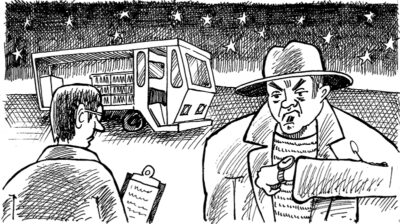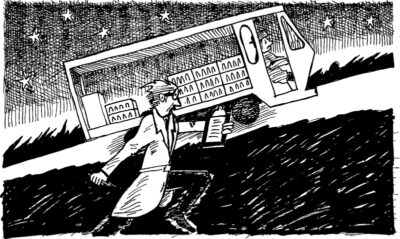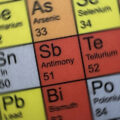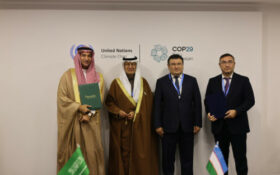“Same words but different perceptions” is a well-recognised problem. In all communications exercises, the question is always realising if what you think is the same as the next person. Technical Editor Mike McDonagh draws on personal experience to illustrate how it is near impossible to avoid subtle differences in interpretation. Far-reaching consequences may result.
If you ask a Canadian and an Australian to draw a tree, the chances are we would see sketches of a fir and a eucalyptus respectively. We recognise them both as trees but they are different. Ask a contractor to plant a tree in your garden and you may not get what you had in your mind when you made the request.
In this season’s FTC offering, I have drawn on two examples of this from personal experience, both of which had far-reaching consequences.
Example 1 – Pure logic
The first is from my early employment years in the 1970s when Britain still had a thriving milk and dairy door-to-door delivery service. The then ubiquitous milk floats were custom designed electric vehicles with a driver’s cab and a flat-bed for carrying crates of milk and other staple food items such as bread and dairy.
They were powered by lead-acid traction batteries and had a range of around 4–10 miles depending on their use and the local terrain. Going back to 1978, I was a technician working for a battery company in south Wales in the UK, as an R&D technician. I was charged with developing a maintenance-free traction battery.
I made a small observation at a technical departmental meeting for analysis of warranty claims. The warranty case being examined was that of a local dairy farmer who also ran a milk delivery service. There was an outstanding warranty claim dating back several months for a 320Ah tubular plate traction battery. The claim had been challenged from the beginning due to the customer’s reputation as one with a long history of expensive warranty claims.
Despite this reputation, the sales department regarded him as a valuable client and justified their low pricing and customer loyalty by casting doubt on the manufactured quality of the cells supplied. I pointed out that there were complications, one significant factor being the daily round. It was a total distance of seven miles which was within the limit for the size of battery.
However, it was also a very hilly area with very steep inclines. The result of the meeting, and my presumptuous intervention, was to send me to the customer to observe a typical round trip. I was to take measurements of the load and the battery voltages, then report back.

I felt very far from being a winner as I turned up at the farm on a very wet and windy Sunday morning at 3.35am, only to be ticked off by the customer for being five minutes late. He had a point. In order to fit my meters, I had to lift the panels on the vehicle’s bed and reach inside to get access to the battery terminals.
I was unaware of the complications of doing this and the inaccessibility of the battery, plus the limited options for fixing the equipment securely in place. However, I did manage this successfully, even getting the probe leads in a good vantage point for easy access to attach the meters without lifting the bed panels or reducing the storage space for the milk crates.
Unfortunately, this delayed the start of the delivery round and I was rather glad that I was following behind the float rather than sitting in it and suffering the customer’s constant acerbic criticism. This arrangement was necessary as my extra weight would have changed the normal driving conditions and made the tests invalid.

Had to run alongside the float
I did get the readings but had to run alongside the float on the pavement. It was tricky as I had to dodge lampposts whilst running sideways like a sprinting crab. As I recall, I did reach a creditable 8mph (I was a lot younger then, and in good shape).

The charger was functioning correctly and the battery seemed to be fully charged before starting the round. A discussion then ensued about how I decided that the battery was fully charged at the beginning of the round. My method was to measure the voltage after the charge had finished, then apply a load for two minutes (press the accelerator pedal with the brakes on) and measure the voltage during the load and a couple of minutes after the load was removed.
However, whilst I thought it a valid method, I was asked why I had not taken an SG reading. That was simple: the battery was in a position close to the top of the bed, making it impossible to reach the vent plugs and insert a hydrometer. I was ordered to return and get some hydrometer readings at the end and the beginning of the round.
This I did the following Sunday. The customer, a very blunt and forthright member of the farming community, left me in little doubt as to his appreciation of this second intervention in his work. This time it was a little better as I did not need to rig up a measuring device. However, I did need to remove more panels from the bed of the float to gain access to the battery vent plugs.
Because of the height restriction, it was necessary to remove the rubber hose from the hydrometer and to use the wider aperture at the end of the glass tube. With this modification, I managed to measure the initial off-charge SG before the customer started loading the float. I then waited for his expected return at 7.15am. He arrived somewhat later, at 8.30am, claiming that the float had been very slow since my last visit, and I only had myself to blame for the extra wait.
Chewed up tadpole in the hydrometer
Ignoring this, I cleared the bed, removed the panels, and took the end-of-round SG readings. The light in the shed was much brighter now as the sun had risen. Because of this, I noticed something floating in the hydrometer. It looked for all the world like a small chewed up tadpole. I emptied the hydrometer contents into a bucket and fished out the foreign body. Even if it was not organic in origin it was something that should not be there.
I confronted the customer with the evidence and asked him what grade of water he had used to top up his cells. At this point the discussion became very heated and he pulled out a warranty leaflet from underneath his battery charger. In this there was a section on maintenance that said:
Only very pure water may be used for topping up the cells according to BS 494-1975. As a minimum, the grade should be equivalent to 1 micron filtered water. Distilled water is recommended.

I looked down at my feet and slowly shook my head. There was clearly nothing else that I could do here.
Back at the factory the sales department blamed the technical department for having such a loose definition of the required water standard. The technical department claimed that they had done that by request of the sales department who had insisted that the previous standard, requiring distilled water or compliance with BS standard BS 494-1975, would be unreasonable and unenforceable as it would not be understood by most of their customers (it was the late 1970s).
The compromise result was to accept the warranty complaint and supply a free water filter to the customer. In fact, the measure of supplying a water filter to give a more robust warranty, was adopted as a sales policy. This tactic became an extra source of revenue, but unfortunately, it was also a corresponding source of loss. This was because it proved more difficult to challenge warranty claims due to customers using incorrect quality water for topping up.
Example 2 – Very good results
The second personal example dates back to my initial years as a consultant. This was a particular job for an Asian company which wanted to improve its tubular cell performance and life to match that of the European high-capacity cells. From the beginning there were some communication difficulties, particularly around the product and process changes that needed to be tested.
As I am sure most lead-acid battery technicians well know, a process or product improvement solution for one company is not always successful in a different factory environment, or even different market conditions.
It is adherence to this maxim that has always prompted me to advise clients that any modification must go through a test period before being incorporated into a product or process change. Even interim process tweaks should be accompanied by tests that monitor the effects on subsequent production stages as well as the final product’s chemistry and performance.
Admittedly, this philosophy has on occasions proved to be a time-consuming and costly affair. However, it does prevent the financial and reputational consequences of battery failures in service or high process scrap rates of interim products.
This consultancy was one of those where both product and processes required substantial modifications. The first was to decide on a cell type and catalogue range to make the trials. This was the DIN size of tubular 2V cells for traction applications. For this the active material in both the positive and negative plates had to increase by 15%.
The theoretical calculations were straightforward and required slightly longer plates with an increase in multitube diameter from 8.2 to 9.1mm for the positive and a thickness increase from 3.9 to 4.2mm for the negative plate. The acid volume would be negatively impacted due to the space taken up by the larger plates.
For this reason, the specification for the fully charged SG of the acid was increased from 1.280–1.290 to 1.300–1.320.
Unsuitable vibrator design
However, another problem reared its head. As luck would have it, the active material requirement to meet the capacity designation could only be met by increasing the positive active material (PAM) dry-filled density, as measured after the filling process.
This was not the easiest of tasks as they used an unsuitable vibrator design with an inadequate amplitude and pulse frequency for their tube filling jigs. Changing this equipment would have taken several months due to design, manufacture, delivery and commissioning time. The consultancy period was one month.
I therefore decided to opt for a material change in the PAM. They had a blend ratio of 70/30 grey to red, lead oxide. It was necessary to add a quantity of litharge (higher density lead oxide) to increase the tamped density of the PAM to the required value of 3.6 to 3.8 g/cc. To do this, I opted for a 60/30/10 mix of grey/red/litharge oxide blend to achieve a final dry-filled density of 3.7 +/-0.1 g/cc.
The litharge was delivered within three days and the blending was done in-house using the existing mixers. That being done, the trials procedures were established with strict instructions for what to record: the vibrator pulse frequency, the method of cleaning, and the weighing of the plates to ensure consistency in the test variables.
The development team was then left to run the trials. I was fully occupied for a couple of days with the cell assembly modifications that were required to accommodate the new plate sizes. This assembly department was half a kilometre from the tube-filling department.
Positive progress report
I was therefore unable to personally supervise the execution of the vibration filling tests. Hearing nothing from the filling team for two days, I contacted the team leader, Jeremy, to ask for a progress report. The conversation went as follows: “Hello Jeremy, I am just contacting you for an update on the filling trials. Any progress?”
Jeremy took a minute to formulate a response: “We are progressing very well, Sir.”
Me: “That’s good news, do you have any results?”
Jeremy: “Yes, Sir, we have a lot of results.”
Me: “OK, and are the results good?”
Jeremy: “Oh yes, Sir, we have very good results, really excellent.”
I was quite relieved, and instructed Jeremy to use those plates to assemble and acid fill five 2V cells, then put them on to a revised formation programme which took into account the additional capacity. We would do two discharge tests and assess the results within four days. We would then be able to decide if any process or design tweaks were required.
The next four days were taken up with reviewing the process modifications and the performance of the new materials during the plate production and assembly stages. Very fiddly modifications to the separator sleeving machine and constructing new internal settings for the cell assembly jigs took up most of the time before the first discharge tests results were available. On the fourth day the arranged capacity test results meeting was called.
My first question was predictable: “Are the results good?”
Jeremy: “Results are very good, Sir.”

I turned to Jeremy who seemed rather unconcerned about this bombshell. “What is going on? You told me that we had good results.”
Jeremy, as usual, was smiling and nodding as he spoke: “We do, Sir, I can show you on the next slide.” The next slide showed the tubular plate weights. Again, I was astounded, they were far too low compared to the target values. This was clearly nonsensical. Once again, I turned to Jeremy and pointed out that these values were way too low.
I asked him if he knew this, when he told me that we had good results, in fact very good results. Still looking pleased about matters, Jeremy explained: “They are good results, Sir. We followed your instructions perfectly and removed all the variables, checked the instruments and verified that they were highly accurate. Look at the mean deviation, Sir, it is very small. These are excellent results.”
I exclaimed: “But all the cells failed the discharge tests!” To which Jeremy replied: “Yes, Sir, that was to be expected from the results. This proves how good the results are.”
Could not believe he was still smiling
I could not believe he was still smiling, nor how pleased he was with the outcome as he passed on the information during the rest of the meeting. The cost of all this in money and time was not his concern, only that he had dutifully followed instructions from the consultant.
For me it was desperately important to find out why the plate weights were far lower than expected. I decided to observe the filling process for myself. The weighing and mixing of the oxide blend went well, and a check of the weigh scales proved that they were accurate. It was during the vibration dry filling procedure that I noticed something wrong.
The vibrator (using a horizontally oscillating pair of weights, not the best) was producing a lower vibration frequency than the vibrators in the other filling booths. Investigation showed that one phase from the 3‑phase supply to the vibrator was not functioning. This meant that the power was reduced and the vibrator was underperforming.
With this revelation the programme was rescheduled and an extra batch of plates made. Naturally I was present this time and able to make the fine adjustments to achieve the desired plate weights and PAM density. The trials for the remaining processes went very smoothly.
This was largely attributable to having gained some practice with the previous underweight plates. The capacity results this time were far better. In fact, the first discharge gave 98% and the second 103% of rated capacity. Within 10 cycles, the cells’ capacities had climbed to a peak average of 109%. They maintained this performance over several hundred cycles, giving the client confidence in the product.
Had the stuffing knocked out of me
I was feeling understandably pleased at this stage. That is until I had the stuffing knocked out of me by the executive board. They pointed out that giving a higher capacity than the catalogue rating was wasting money. Furthermore, the development budget had gone 7% over my estimates.
Despite this however, they recognised that I could tweak the design and bring the product costs back in line with the programmed values. So overall they were satisfied with the consultancy work. For myself, I had learned two valuable lessons: how not to communicate, and how not to run a development programme.












